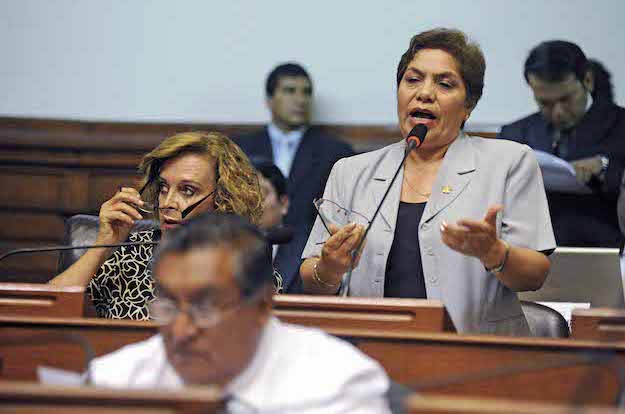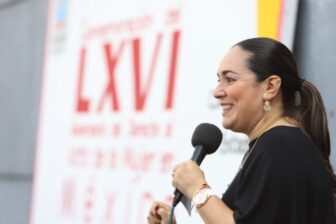This article is adapted from AQ’s special report on closing the gender gap.
In 1991, Argentine women began to transform electoral politics in Latin America — and around the globe. Thanks to feminist activism, and last-minute support from a president seeking a public relations win, the Argentine Congress passed the modern era’s first gender quota law. Today, more than 70 countries have laws that require political parties to nominate certain percentages of women to their tickets. Latin America remains in the vanguard, with such quotas in every country except Guatemala and Venezuela.
It wasn’t, however, without a fight.
Latin America’s redemocratization in the 1980s had overwhelmingly benefited men. Women had led pro-democracy movements, but were marginalized once electoral politics returned. Only about 5% of legislative seats in the first post-transition elections were won by women.
Regionwide, the needle hardly moved in subsequent years. Throughout the 1990s, women averaged less than 10% of the region’s lower or unicameral legislatures. In 1997, upon introducing Peru’s quota law, Congresswoman Luz Salgado remarked that “a patriarchal and machista political culture is responsible for the fact that of 2013 parliamentarians, only 84 have been women.” Rather than wait for gender bias to disappear with time, women sought quotas to fast-track their access to elected office.
Gender quotas have helped advance that goal. In 2020, women hold 30% of seats in Latin America’s lower or single chambers and 28% in the senates. In Argentina, Bolivia, Costa Rica, Nicaragua and Mexico, women constitute nearly half the legislature.
The road has not been easy. Men legislators often acquiesced, but wrote laws with loopholes, allowing party leaders to look like good feminists while paying few electoral costs. But women kept the pressure on, gradually strengthening gender quotas.
The big lesson from these 30 years is that just having a quota is not enough — the design of the quota itself matters tremendously.
First, thresholds must be high. Most countries began with quotas set at 20% or 30%, but the new benchmark is gender parity, or 50%. Eight countries — Argentina, Bolivia, Costa Rica, Ecuador, Honduras, Mexico, Nicaragua and Panama — currently require gender balance among legislative candidates. Peru will apply parity in the 2021 elections.
Second, quotas must match electoral systems. Latin American countries use different forms of a party list system. Rank-ordered lists of candidates are usually closed (voters select the list as-is) or open (voters can move candidates up or down). Many initial quota laws lacked rules about list order, letting political parties relegate women to the lists’ bottom. Now, the gold standard is “vertical parity,” a 50% gender quota alternating men’s and women’s names down the list. Such mandates work especially well in closed-list systems, but the principle translates easily. In Mexico, for instance, 300 lower-house members are elected in single-seat constituencies, and the 2016 electoral law says political parties cannot nominate women “exclusively” to losing districts.
Third, give parties little wiggle room. For example, Mexico’s first quota law — passed in 2002 — didn’t apply to parties selecting candidates via internal primaries (rather than nomination by the party leader). The loophole closed in 2011, when women lawyers, journalists, activists and politicians sued and won. Until recently in Costa Rica, parties would often implement vertical parity, but always starting with a man. The election agency now requires “horizontal parity,” meaning that women lead half of all lists presented by parties.
Finally, sanctions and enforcement are critical. Quota laws typically rely on electoral authorities to ensure that parties do not just fill the quota, but follow the rules about ballot order and district assignment. Authorities must remain vigilant to shenanigans. Take Mexico in 2018: Parties in the state of Oaxaca attempted to fill the quota with fake transgender candidates—men who dressed as women, but had never done so until their nomination.
“Political parties are the most creative when it comes to breaking the rules,” said María del Carmen Alanis, former chief magistrate of Mexico’s federal electoral court. “The electoral tribunals have compelled them to comply.”
The combination of strong design and strong enforcement separates Latin American countries into two groups. Those that implement gender parity and enforce the law — Argentina, Bolivia, Costa Rica, Ecuador, Mexico and Nicaragua — elect an average of 46% women to their lower or single chamber of congress. By contrast, countries with weak or no quotas elect an average of 22% women. This group includes Colombia and Uruguay, which have thresholds below 40%, and Honduras and Panama, which have open-list systems and no placement mandates. While Brazil has a gender quota law dating back to 1995, electoral authorities largely look away. A low 30% gender quota, half-hearted enforcement and open lists place Brazil dead last among Latin American countries in electing women to congress.
By contrast, top performers have extended gender parity well beyond the legislature. In 2009, Bolivia and Ecuador reformed their constitutions to mandate gender parity for all government branches. Mexico followed in 2019, rewriting the constitution to require gender parity for the executive, judiciary and all state organs. Feminists campaigned using the hashtag #ParidadEnTodo (parity in everything).
Viewing gender parity as a democratic best practice resonates throughout the region. In 2019, when Chile’s widespread protests over corruption and inequality prompted calls for a constitutional convention, women demanded a constitutional assembly with gender parity. They marched, wrote op-ed pieces, drafted bills and staged protests inside congress — and won. If Chileans choose a citizens’ constitutional convention in the October 2020 referendum, the electoral formula will guarantee gender balance not just among candidates, but among the representatives. Evoking women’s exclusion from Chile’s 1990 democratic transition, their rallying cry is #NuncaMasSinMujeres (never again without women).
Of course, Latin America has not eliminated sexism in politics. Alanis notes that while laws have changed and electoral authorities have prevented injustice, political parties’ patriarchal culture remains intact. Even in Costa Rica, which boasts vertical and horizontal parity, Congresswoman Nielsen Pérez Pérez described a “political culture and political leadership dominated by men.” She lists obstacles women face, like more care work, less access to parties’ campaign funds and gender-based harassment and violence.
Latin America cannot rest on its success, but the gains remain undeniable. Argentina’s 1991 quota law transformed electoral politics. Today, record numbers of women hold legislative office because of that law and the work of women activists to transform hollow promises into real changes. If Latin American countries continue to design and implement smart quota laws, even more women can secure a seat at the table.
—
Piscopo is associate professor of politics and affiliate faculty of Latino/a and Latin American Studies at Occidental College and a leading expert on women and electoral politics.







